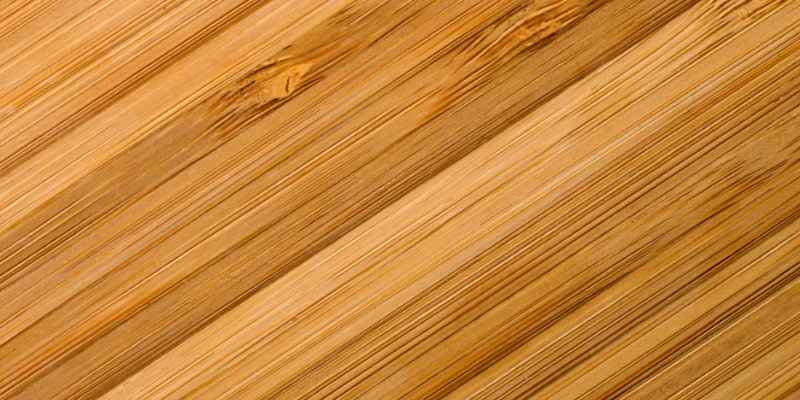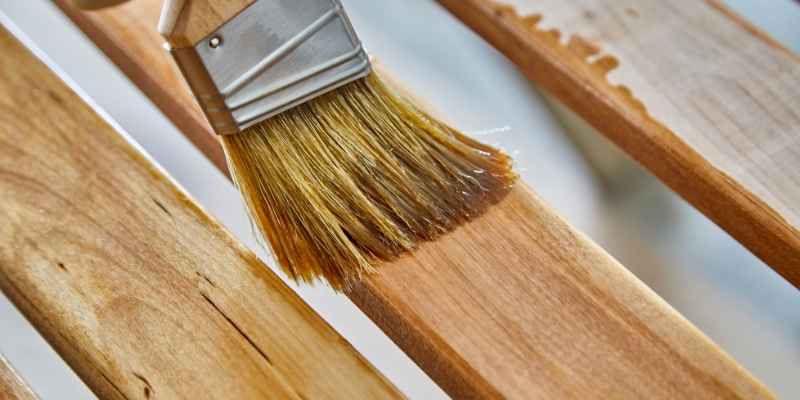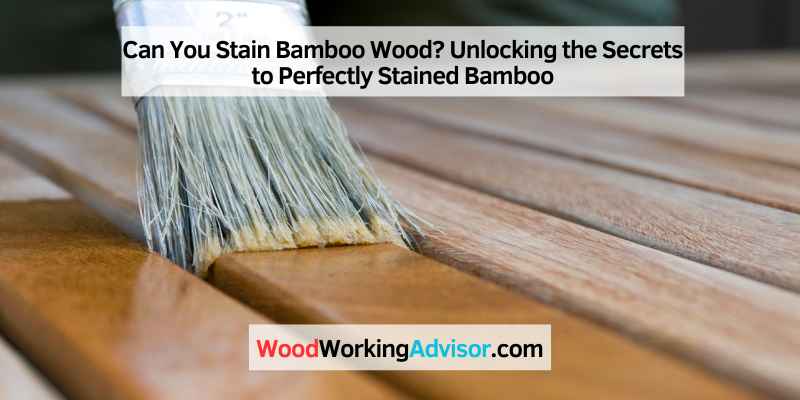Yes, you can stain bamboo wood for a customized look and protection. Bamboo is a versatile and sustainable material that has gained popularity in home decor and construction.
If you have bamboo furniture, flooring, or other bamboo products, you may be wondering if it can be stained to match your desired style. The good news is that bamboo wood can indeed be stained, allowing you to change its color or enhance its natural beauty.
Staining bamboo not only provides a customized look but also adds a layer of protection to the wood surface. We will explore the staining process for bamboo wood and provide some tips to achieve the best results.
Why Stain Bamboo Wood
Staining bamboo wood is possible, as it allows you to enhance its natural beauty and customize its appearance to match your decor.
Why Stain Bamboo Wood?
Staining bamboo wood is an effective way to enhance its appearance and increase its durability. By applying a stain, you can transform the natural color of bamboo to match your desired aesthetic. Additionally, staining bamboo wood provides a protective layer that can help prolong its lifespan and prevent damage from external elements. Let’s delve into the specific reasons why staining bamboo wood is a popular choice.
Enhancing The Appearance
Bamboo wood is known for its beautiful natural color. However, if you want to customize the look of your bamboo furniture, flooring, or other items, staining is the perfect solution. Stains come in a variety of shades and hues, allowing you to achieve the exact color you desire. Whether you prefer a rich, dark tone, or a light, honey-like finish, stains can help you create a personalized and unique look.
Moreover, staining bamboo wood highlights the natural grain and texture of the material, adding depth and character to the surface. This can make your bamboo pieces stand out, complementing your overall interior design scheme. Whether you’re going for a rustic, modern, or traditional style, staining can help you achieve the desired effect.
Increasing Durability
While bamboo wood is inherently durable, applying a stain can further enhance its strength and longevity. The staining process involves sealing the bamboo, creating a protective barrier that shields it from moisture, UV rays, and everyday wear and tear. This layer of protection makes stained bamboo wood more resistant to scratches, staining, and fading over time.
Stained bamboo wood also helps prevent the growth of mold and mildew, which can deteriorate the material and compromise its structural integrity. This added resistance to moisture makes stained bamboo wood an excellent choice for areas with high humidity or moisture exposure, such as bathrooms or kitchens.
By increasing the durability of bamboo wood through staining, you can enjoy its beauty and functionality for years to come, without worrying about frequent maintenance or premature deterioration.
In conclusion, staining bamboo wood not only allows you to customize its appearance but also provides essential protection and durability. Whether you’re looking to enhance the aesthetics of your bamboo furniture or increase its resistance to daily wear and tear, staining is a worthwhile investment. With a wide range of stain colors available, you can transform your bamboo wood into a statement piece that blends seamlessly with your style and stands the test of time.

Choosing The Right Stain
Bamboo wood can be stained to add a touch of color and enhance its natural beauty. Whether you prefer a light or dark shade, choosing the right stain can transform the look of your bamboo furniture or flooring, providing both protection and aesthetic appeal.
When it comes to staining bamboo wood, choosing the right stain is crucial. The right stain can enhance the natural beauty of bamboo while providing protection and durability. Whether you want to highlight its warm tones or transform its appearance, there are various types of stains to consider. Water-based stains, oil-based stains, and gel stains are popular choices for staining bamboo wood. Each type of stain has its own unique properties and benefits.
Water-based Stains
Water-based stains are an excellent choice for staining bamboo wood. They are easy to apply and offer a quick drying time, making them convenient for DIY projects. These stains are also known for their low odor and environmentally friendly nature. Water-based stains come in a wide range of colors, allowing you to match your bamboo wood to any desired shade. Additionally, they have excellent UV resistance, making them suitable for both indoor and outdoor applications.
Oil-based Stains
If you’re looking for a stain that penetrates deeply into the bamboo wood, oil-based stains are a great option. They enhance the natural beauty of bamboo by enriching its color and highlight the grain patterns. Oil-based stains provide a durable finish that protects the wood from moisture and daily wear and tear. They also offer a long-lasting finish that can withstand regular cleaning and maintenance. However, oil-based stains typically have a longer drying time compared to water-based stains.
Gel Stains
Gel stains are another popular choice for staining bamboo wood. These thick, gel-like stains are easy to control and provide an even application. They are perfect for vertical surfaces or intricate bamboo wood projects. Gel stains offer a longer working time, allowing you to achieve the desired color and consistency. They are available in a variety of colors and can be easily layered to achieve the desired depth and shade. Gel stains also provide good coverage and can help conceal imperfections on the bamboo surface.
Preparing Bamboo Wood For Staining
Before you can transform your bamboo wood with a stunning stain, it’s important to prepare the surface properly. Taking the time to clean, sand, and apply a pre-stain conditioner will ensure the best possible results. In this section, we will guide you through each step of the preparation process to help you achieve a flawless finish. Let’s dive right in!
Cleaning The Surface
To begin, start by cleaning the bamboo wood surface thoroughly. This step is crucial as it removes any dirt, dust, or grime that could affect the absorption and application of the stain. Here’s a straightforward method to clean the surface:
- Fill a bucket with warm water.
- Add a few drops of mild dish soap and mix it well.
- Dip a soft cloth or sponge in the soapy water and wring out any excess moisture.
- Gently wipe the bamboo wood surface in smooth, circular motions, ensuring you cover the entire area.
- Rinse the cloth or sponge in clean water and repeat the process to remove any soap residue.
- Allow the surface to dry completely before moving on to the next step.
Sanding The Wood
Sanding the bamboo wood is an essential step to create a smooth and even surface for the stain to adhere to. Here’s how you can sand the wood effectively:
- Start by using medium-grit sandpaper (around 150 grit) to sand the entire surface.
- Sand in the direction of the bamboo wood grain to prevent any scratches or marks.
- After the initial sanding, switch to a finer-grit sandpaper (around 220 grit) for a smoother finish.
- Continue sanding until the surface feels smooth to the touch and any imperfections are removed.
- Remember to wipe away any sanding dust with a clean cloth before proceeding.
Applying Pre-stain Conditioner
Applying a pre-stain conditioner is crucial when staining bamboo wood. It helps to seal the wood pores, creating a more uniform absorption of the stain and minimizing blotching. Follow these steps to apply a pre-stain conditioner:
- Ensure the bamboo wood surface is clean and dry.
- Using a clean, lint-free cloth, apply a thin, even coat of pre-stain conditioner over the entire surface.
- Allow the conditioner to penetrate the wood for the recommended time specified by the manufacturer.
- Using a clean cloth, gently wipe away any excess conditioner that may not have been absorbed.
- Let the pre-stain conditioner cure according to the manufacturer’s instructions before moving on to the staining phase.
Now that your bamboo wood is meticulously prepared, it’s time to move on to the exciting part: staining! Stay tuned for our next blog post, where we’ll guide you through the process of choosing and applying the perfect stain for your bamboo wood project.
Applying The Stain
When it comes to adding a touch of color and enhancing the natural beauty of bamboo wood, staining can be a great solution. By applying a stain, you can customize the appearance of bamboo and achieve the desired look for your project. The process of staining bamboo wood involves a few different methods, each with its own advantages. In this section, we will explore the three main techniques for applying stain to bamboo wood: using a brush, spraying the stain, and wiping the stain.
Using A Brush
If you prefer a hands-on approach, using a brush to apply the stain to bamboo wood can give you precise control over the application. This method allows you to evenly distribute the stain and work it into the bamboo’s surface, ensuring maximum coverage. To use a brush for staining, follow these steps:
- Prepare the bamboo wood by sanding it lightly to create a smooth surface.
- Choose a high-quality brush suitable for the type of stain you are using.
- Dip the brush into the stain and gently tap it on the side of the container to remove any excess.
- Apply the stain to the bamboo in long, smooth strokes, following the wood’s grain.
- Continue applying the stain until you achieve the desired color intensity.
- Allow the stain to dry completely before applying any additional coats or finishing products.
Spraying The Stain
If you are working on a larger project or prefer a faster method, spraying the stain onto bamboo wood can be an efficient option. This technique allows for quick and even coverage, minimizing the risk of brush strokes. To spray the stain onto bamboo wood, consider the following steps:
- Ensure you have a well-ventilated area or work outside to avoid inhaling fumes.
- Use a high-quality sprayer specifically designed for wood staining.
- Fill the sprayer with the desired stain, following the manufacturer’s instructions.
- Hold the sprayer approximately 6-8 inches away from the bamboo and apply an even coat of stain, moving in a smooth back-and-forth motion.
- Avoid overspraying by using controlled bursts and maintaining a consistent distance from the bamboo.
- Allow the stain to dry thoroughly before adding additional coats or applying finishing products.
Wiping The Stain
Another method for applying stain to bamboo wood is by wiping it onto the surface. This technique allows for more control over the color intensity and can create a unique, textured effect. Here’s how you can achieve optimal results when wiping the stain:
- Prepare the bamboo wood by sanding it lightly to achieve a smooth and clean surface.
- Pour the stain into a container suitable for dipping a clean cloth.
- Dip a soft, lint-free cloth into the stain, ensuring it is saturated but not dripping.
- Wipe the stained cloth onto the bamboo in smooth, circular motions, applying an even coat of stain.
- Continue this process until you achieve the desired color and texture.
- Allow the stain to dry completely before applying any further coats or finishing products.

Finishing And Maintaining Stained Bamboo
Bamboo wood is not only beautiful but also durable, making it a popular choice for flooring, furniture, and other projects. However, to enhance its aesthetics and extend its lifespan, you may consider staining bamboo wood. Staining bamboo not only adds a touch of color but also protects the wood from potentially damaging elements. In this article, we will explore how to properly finish and maintain stained bamboo wood.
Applying A Clear Finish
Applying a clear finish to stained bamboo wood is crucial for achieving a polished look and protecting the stain from wear and tear. A clear finish acts as a sealant, creating a barrier between the wood and external factors such as moisture, dirt, and UV rays. Here’s a step-by-step guide to applying a clear finish to your stained bamboo wood:
- Start by thoroughly cleaning the surface of the bamboo to remove any dust or debris. You can use a damp cloth or a soft brush to gently remove the particles.
- Next, ensure the bamboo is completely dry before applying the clear finish. This will prevent any moisture from getting trapped beneath the finish, which can lead to durability issues.
- Choose an appropriate clear finish for bamboo wood, such as polyurethane or varnish. These finishes are known for their durability and ability to withstand the demands of everyday use.
- Apply the clear finish using a brush or a soft cloth, following the manufacturer’s instructions. Ensure you apply an even coat, working in the direction of the bamboo’s grain.
- Allow the first coat to dry completely before applying additional coats. Depending on the finish and desired level of protection, you may need to apply multiple coats.
- Once the final coat is dry, lightly sand the surface of the bamboo with fine-grit sandpaper. This will remove any imperfections or bubbles, resulting in a smooth and flawless finish.
Protecting Against Wear And Tear
Stained bamboo, like any other wood, is susceptible to everyday wear and tear. To keep your stained bamboo wood looking its best for years to come, there are a few steps you can take to protect it:
- Place protective pads or coasters underneath furniture legs to prevent scratches and indentations.
- Avoid dragging heavy objects across the bamboo surface, as this can cause deep scratches or gouges.
- Use area rugs or mats in high-traffic areas to minimize the impact of dirt and debris.
- Keep sharp objects away from the bamboo surface to prevent accidental scratches.
Regular Maintenance
Maintaining stained bamboo wood is relatively simple yet essential for preserving its beauty and longevity. Here are some regular maintenance tips to keep in mind:
- Dust or sweep the surface regularly to remove any dirt or debris.
- Wipe up spills immediately to prevent staining or water damage.
- Use a mild, non-abrasive cleaner specifically designed for bamboo wood to clean the surface occasionally.
- Avoid using harsh chemicals or abrasive cleaners, as they can damage the stain and finish.
- Reapply a thin coat of clear finish every few years to maintain the protective barrier and refresh the stained bamboo’s appearance.
Conclusion
Bamboo wood can indeed be stained, offering versatility in its appearance and allowing it to complement various design preferences. By carefully preparing the surface and choosing the right stain, individuals can achieve stunning results that enhance the natural beauty of the bamboo while adding a touch of personalization to their space.
Whether it’s a darker shade or a lighter hue, staining bamboo wood provides a cost-effective and eco-friendly option for those seeking a unique and charming aesthetic. Explore the possibilities and transform your bamboo furniture or flooring today!


